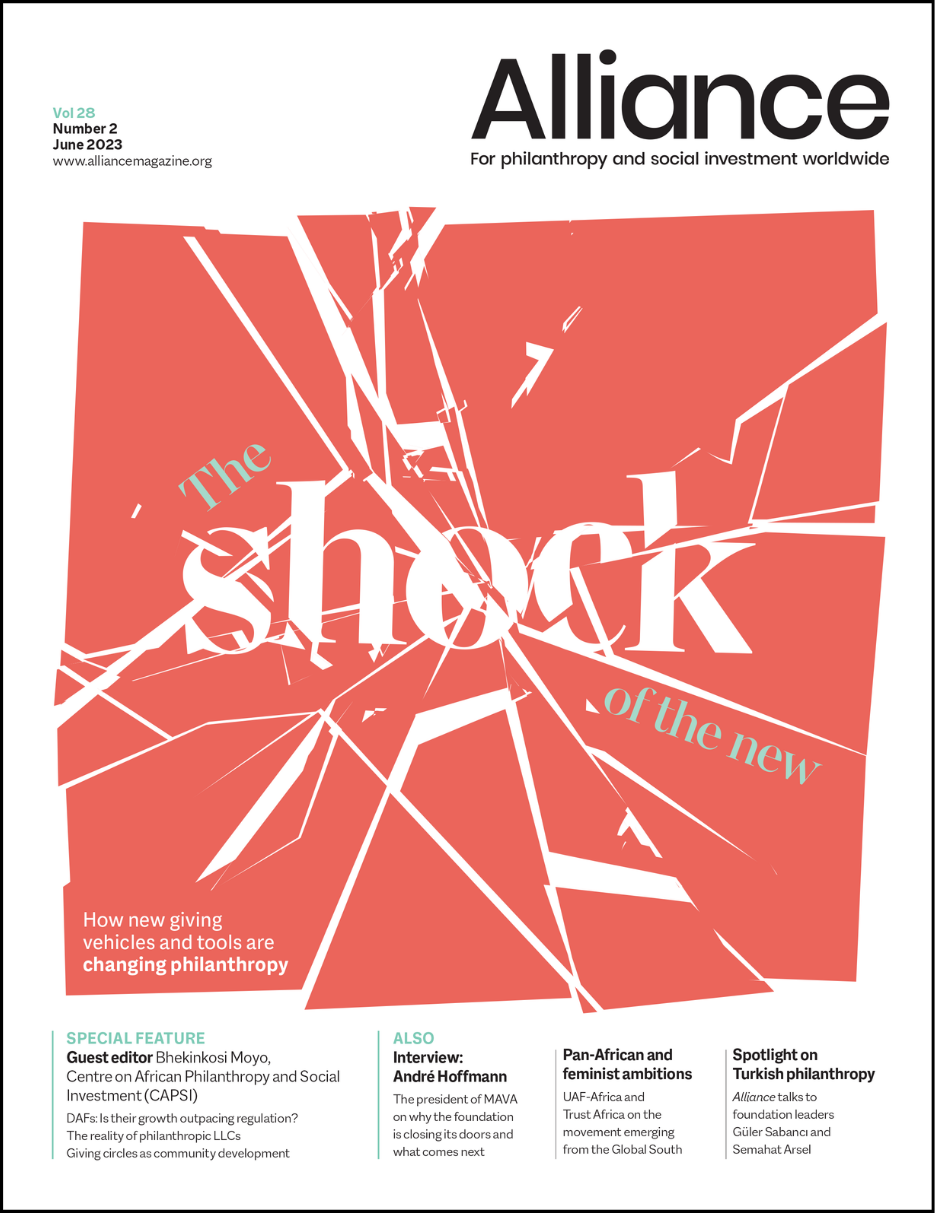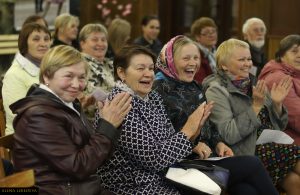The concept of newness in giving vehicles and tools has been dominated by northern habits of thought and experience in philanthropy
In May, the African Grantmakers’ Affinity Group (AGAG) meeting in New York conducted an exercise to ascertain whether participants understood the concept of a ‘philanthropy adviser’, and whether or not they had connected with one in their home countries, community or work. Under this heading were included the so-called new vehicles and tools like donor advised funds (DAFs), family offices and limited liability companies (LLCs). The exercise showed that only 24 per cent of participants were familiar with the concept. However, as the conversation progressed, two things became clear. First, that many in the room actually operated as philanthropy advisers but are not formally recognised as such. Second, that what is formally named and recognised in developed markets remains informal in developing countries for the most part. That doesn’t mean they aren’t there. As one of the participants noted, ‘philanthropists can give in any format they wish to, from their pockets or through foundations, family offices or new vehicles such as DAFs but what is more important is the research that needs to be conducted to ascertain the appropriate vehicle’ and ‘to know how local giving looks.’
For me, the above exercise and the conversations provided an appropriate lens through which to view the different articles in this June special feature of Alliance. Speaking to the RS Group’s founder Annie Chen and managing director Ronie Mak drove home the point that context matters. For instance, while social impact bonds are blossoming in some regions including in South Africa, in Hong Kong so far the approach has not been adopted. This is because it does not resonate with the current context. Blended finance, however, is a vehicle that is currently used by the RS Group in their exploration of new ways of undertaking social investing by using a ‘total portfolio approach’, and by other donors in Hong Kong. Context therefore does matter. In his introduction to this special feature, Andrew Milner writes eloquently about this when he discusses the idea of relativity in understanding ‘newness’. What does ‘new’ refer to when we talk about new vehicles and tools of giving? What is a long tradition of practice in one place can be a novelty in another. Equally, change varies in speed and scope. Certain regions adopt change faster than others. At times what happens at a local level has implications for what happens at a global level and vice versa. It is useful to think of newness and its adaptation or adoption in terms of theoretical frames of variable geometry (gradualism) and subsidiarity.
Philanthropists can give in any format they wish to, from their pockets or through foundations, family offices or new vehicles such as DAFs but what is more important is the research that needs to be conducted to ascertain the appropriate vehicle.
Using the principle of variable geometry, it is understandable why some regions especially in developed contexts have experienced substantial innovations in philanthropy, have seen a big rise in DAFs and LLCs, the increasing use of technology especially in fundraising, as well as entrenched a culture of building endowments. Other regions are yet to follow some of these trends. The articles in this special feature are predominantly from developed markets and this is because the existence of the phenomenon under study is more pronounced in those markets. There are, however, other vehicles of giving in other regions that are not covered by the contributors. These include the rise in philanthropy advisers, giving through Non Fungible Tokens (NFTs) and crypto-currencies (though an article on crypto-philanthropy appears in the online coverage of the feature),[1] waqfs, social impact bonds and various in-kind giving vehicles found mainly in Africa and other parts of the Global South. For example, giving through pooled funds is on the increase in emerging markets and quasi-endowments are emerging as new structures to sustain organisations. Giving in-kind in poorly performing economies is also on the rise. If these in-kind giving mechanisms were to increase in scope and size in developed markets, there is a possibility they would be characterised as new. Similarly, the adoption of DAFs, LLCs and endowments in regions where they are not popular now would also be characterised as new. The implication and the sense one gets when reading the articles in this special feature is that there is an assumption that new vehicles are being introduced where there are long traditions of giving, and as such the analysis immediately shifts to established contexts such as the UK and US.
The articles in this special feature address these vexing questions. Different regions have different experiences because of their varied histories (of philanthropy, colonisation, globalisation, economic development and political foundations), state of philanthropic practice, cultural underpinnings and creative impulses. For example, DAFs and LLCs are recognised vehicles in the US and most of Europe, but these are limited and almost non-existent in regions such as Africa and most parts of the Global South. At the same time, regions such as Africa and Asia have long traditions of giving based on the local culture and context which would probably make some of the vehicles in the Global North irrelevant and inapplicable in those contexts. Similarly, there are certain vehicles that have resonance in most regions of the world. Endowments, for example, exist in all regions but in different scope, size and structures with different outcomes. In Brazil, for example, while the concept of an endowment is recent, it has expanded over the years following the growth in philanthropy. Starting in the 1950s, the endowment concept was used mainly by families and businesses to build legacy. By 2000, there were six known endowments in Brazil and since the 2019 law on endowments, there has been what the authors of the article chronicling their rise describe as a boom.
Online giving is also on the increase and there was no better illustration of this than the giving towards Ukraine recently. Vicky Reeves in this special feature projects that online giving will continue to grow despite tough economic times. There has been an increase in giving through different payment gateways such as credit cards, mobile payments, digital platforms such as goDonate, PayPal and digital wallets among others. According to Reeves, in 2022 alone, digital wallets accounted for 39 per cent of all UK donations. This is likely to be a growing trend in other regions, too.
At the same time, regions such as Africa and Asia have long traditions of giving based on the local culture and context which would probably make some of the vehicles in the Global North irrelevant and inapplicable in those contexts.
There are certainly new or resuscitated vehicles of giving that have added to the philanthropy landscape in addition to the traditional forms of foundations and their conventional grant-making. While these vehicles might be pronounced in some regions, they are yet to take off in others. Their emergence, however, has not been smooth sailing. Two schools emerge in the articles that follow. The first school argues that traditional forms of foundations and their grantmaking approaches are not effective for social impact and as a result elite philanthropists have responded by creating innovative ways to achieve impact. In this case, the use of LLCs is defended by Scott McDonald who argues that ‘LLC founders are motivated by the fact that traditional philanthropic giving structures are not optimised for addressing complex social issues’. Further, McDonald says that ‘traditional foundations are constrained by outdated regulations that perpetuate power imbalances and reinforces the status quo.’ For example, foundations only spend about 5 per cent of their net assets, the other 95 per cent sitting in endowments. LLCs and DAFs make it possible for foundations to circumvent this and give at a bigger scale especially for causes that might require a lot of resources delivered quickly and flexibly such as the looming climate change which the usual grantmaking approach is not well adapted do.
The second school sees DAFs and LLCs as ineffective, dangerous and created in the main to avoid government regulation. This school argues that these vehicles are too flexible and lack accountability. One of the writers in the special feature, for example, argues that DAFs are growing at a faster pace, but this has not translated to an increase in charitable giving. Ray Madoff cites the statistic that more than 30 per cent of charitable giving is now going to intermediaries like DAFs rather than directly to charity. This represents a big loss to charities. In other words, more than $300 billion over five years is kept by DAFs and there is no guarantee when or in what amounts this money will ever reach charities directly. This criticism of DAFs is well captured by Madoff when she writes: ‘DAFs provide a convenient alternative to giving to private foundations and enable donors to achieve maximum tax benefits for their giving. But if they are to benefit society more broadly, we must provide regulatory assurances of the results.’
There are certainly new or resuscitated vehicles of giving that have added to the philanthropy landscape in addition to the traditional forms of foundations and their conventional grant-making.
Lack of regulation or outdated regulation seems to be the key area of concern in criticisms of new vehicles. It would appear that elite donors have moved faster than regulation and where there is regulation it is either outdated or did not anticipate developments in the sector.
There are still gaps in the study of new vehicles and tools of giving. The focus of the current special feature has been predominantly on DAFs, LLCs and endowments. Other trends – the development of family offices, online giving, giving circles – have featured less prominently and still others – social impact bonds, philanthropy advisers and in-kind giving mechanisms – not at all. Some of these gaps will be addressed in the online coverage of the topic, though they also highlight the fact that additional research on these will complement the articles in this special feature. Nevertheless, the current feature contains insightful reflections which will go a long way in improving how philanthropy is practised in different jurisdictions. As contexts and new developments occur, new or adapted vehicles of giving will also emerge.
Bhekinkosi Moyo is adjunct professor at the Centre on African Philanthropy and Social Investment (CAPSI), Wits Business School, Wits University, South Africa.
Email: bhekinkosi.moyo@wits.ac.za
Twitter: @bheki_moyo
Footnotes
- ^ tinyurl.com/crypto-philanthropy










Comments (0)